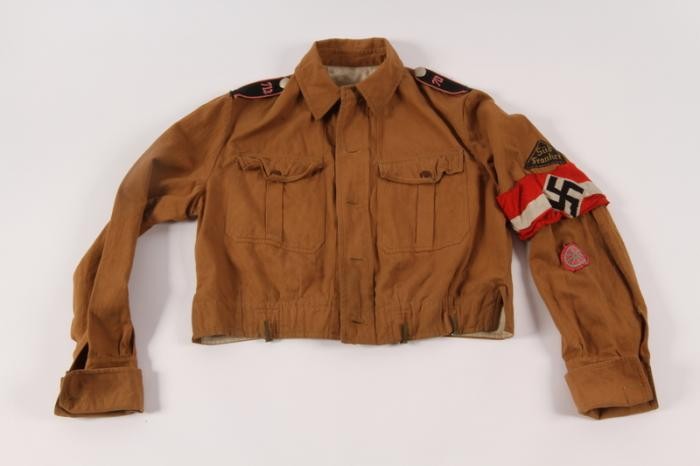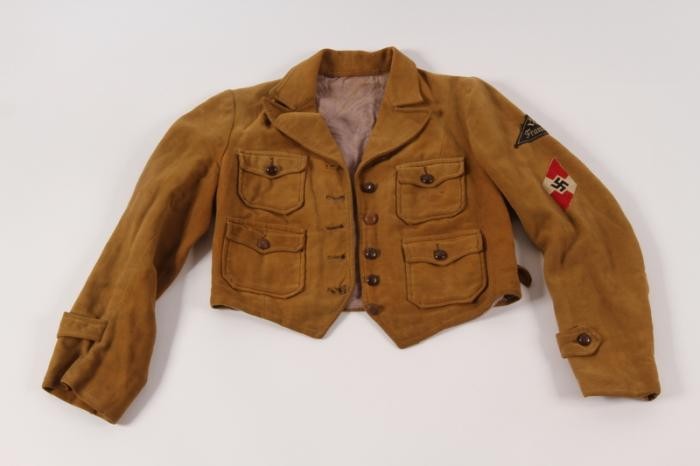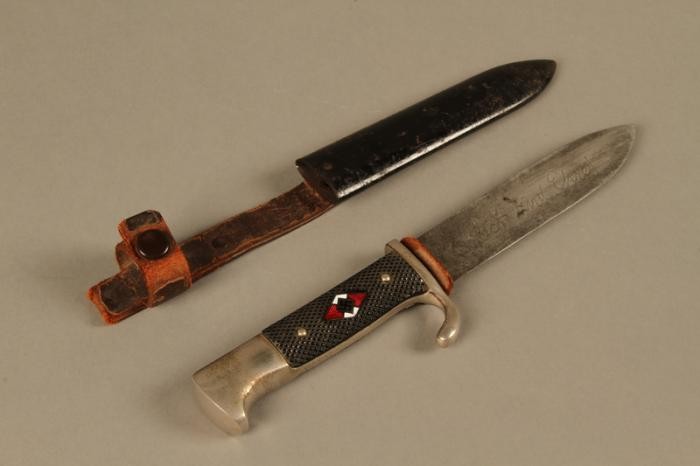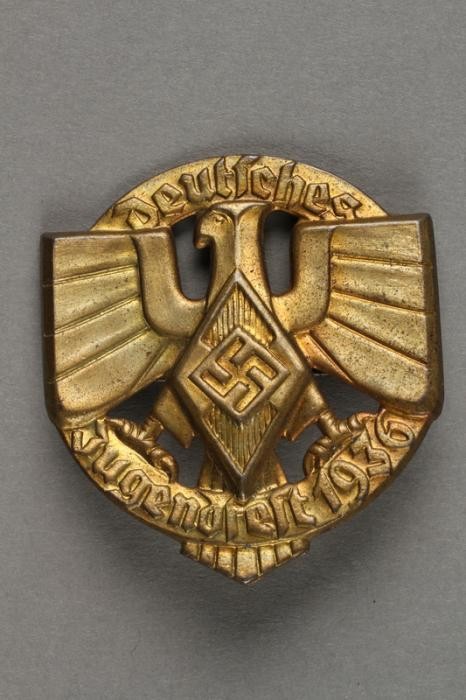Agnes Allison (née Agnes Suzannah Halàsz) was born on October 28, 1926, in Budapest, Hungary, to Ilona Gero and Robert Halász. She had a younger sister, Judy. Agnes attended a private German school established for the children of diplomats. There was a Hitler Youth movement at the school. Agnes and her family were forced out of their home following the German occupation of Hungary. She went into hiding in December 1944.
Beginning in 1933, the Hitler Youth and the League of German Girls had an important role to play in the new Nazi regime. Through these organizations, the Nazi regime planned to indoctrinate young people with Nazi ideology. This was part of the process of Nazifying German society. The aim of this process was to dismantle existing social structures and traditions. The Nazi youth groups were about imposing conformity. Youth throughout Germany wore the same uniforms, sang the same Nazi songs, and participated in similar activities, as Agnes describes here.
Item View
Hitler Youth summer uniform jacket with an armband and insignia designating the regiment and district to which the member belonged.
Beginning in 1933, the Hitler Youth and its organization for girls and young women, the League of German Girls, played an important role the new Nazi regime. Through these organizations, the Nazi regime indoctrinated young people with Nazi ideology, including antisemitism and racism. All prospective members of the Hitler Youth had to be "Aryans" and "genetically healthy." Their duty was to serve Adolf Hitler and the Third Reich. Hitler Youth boys and girls were required to wear military-style uniforms, in keeping with the "soldierly" character of the Nazi Party, and conform to certain standards of behavior. Uniforms such as this one emphasized the regimented nature of the Hitler Youth.
US Army soldier Arthur R. Myers obtained this uniform during his military service in World War II.
Item View
This League of German Girls jacket has two embroidered cloth patches handstitched to the upper left sleeve: a dark triangle displaying the name of the member’s region, South Franconia (Süd Franken), and a Hitler Youth insignia.
Beginning in 1933, the Hitler Youth and its organization for girls and young women, the League of German Girls, played an important role in the new Nazi regime. Through these organizations, the Nazi regime indoctrinated young people with Nazi ideology, including antisemitism and racism. All prospective members of the Hitler Youth had to be "Aryans" and "genetically healthy." Their duty was to serve Adolf Hitler and the Third Reich. Hitler Youth boys and girls were required to wear military-style uniforms, in keeping with the "soldierly" character of the Nazi Party, and conform to certain standards of behavior. Youth of both genders had to take part in physical exercise to prepare for their future lives in Nazi Germany. Boys engaged in military training, while the League of German Girls primed girls to be future wives and mothers. It trained girls to care for the home and family. Girls also learned skills such as sewing, nursing, cooking, and household chores.
This jacket was brought back to the United States by Arthur R. Myers, a US Army soldier who participated in the Allied invasion of Nazi Germany.
Item ViewPeter was six years old when his mother enrolled him in a special Hitler boarding school for future Nazi Party officials in 1935. He studied traditional academic subjects, but was constantly exposed to Nazi ideas and prepared for a military life. Peter was also a member of the Hitler Youth. He came to believe in Hitler as the savior of Germany. Peter would later describe his indoctrination as a subtle process. It took two years after the war had ended for Peter to come to terms with the atrocities that the Germans had in reality committed—a process he described as very painful. He eventually moved to the United States. He became a historian and professor of Modern German History at the University of South Carolina.
Item ViewGuy Stern was born on January 14, 1922, in Hildesheim, Germany, into a Jewish family. As a child, he attended a German school, where he had many non-Jewish friends.
Beginning in 1933, the Hitler Youth and the League of German Girls had an important role to play in the new Nazi regime. Through these organizations, the Nazi regime planned to indoctrinate young people with Nazi ideology. This was part of the process of Nazifying German society. The aim of this process was to dismantle existing social structures and traditions. The Nazi youth groups were about imposing conformity. Youth throughout Germany wore the same uniforms, sang the same Nazi songs, and participated in similar activities.
Guy describes how propaganda and membership in the Hitler Youth turned one of these friends from his staunchest defender to his worst enemy.
Item ViewHerbert Oppenheimer was born on January 4, 1926, in Berlin, Germany. He lived with foster parents, who were Seventh-Day Adventists. While living with his foster parents, he had to join Hitler Youth along with everyone else in his class at school. During this time, he learned that he was Jewish. The school consequently expelled him from the Hitler Youth. All prospective members of the Hitler Youth had to be "Aryans." He had to leave his foster parents in April 1939, and lived in an orphanage run by the Jewish community until he was 14.
Beginning in 1933, the Hitler Youth and the League of German Girls had an important role to play in the new Nazi regime. Through these organizations, the Nazi regime planned to indoctrinate young people with Nazi ideology. This was part of the process of Nazifying German society. The aim of this process was to dismantle existing social structures and traditions. The Nazi youth groups were about imposing conformity. Youth throughout Germany wore the same uniforms, sang the same Nazi songs, and participated in similar activities.
Herbert describes the focus on physical exercise during the time he was a member of the Hitler Youth.
Item View![Hitler Jugend Leistungsabzeichen [Hitler Youth] proficiency badge Silver badge with heavy patina. The round center includes a swastika surrounded by runic like text. A large arrow runs behind the center pointing upwards.](https://encyclopedia.ushmm.org/images/large/e41f84d4-22a3-4a1e-98b1-bc088d8ca687.jpg)
This Hitler Youth proficiency badge would have been awarded for the successful completion of a series of tests measuring physical and ideological proficiency. Success in these tests was rated according to criteria in the Hitler Youth identity document and performance book known as the Leistungsbuch. On this badge, the arrow shape (the tyr-rune) represents the warrior god Tyr.
Beginning in 1933, the Hitler Youth and the League of German Girls had an important role to play in the new Nazi regime. Through these organizations, the Nazi regime planned to indoctrinate young people with Nazi ideology. This was part of the process of Nazifying German society. The aim of this process was to dismantle existing social structures and traditions. The Nazi youth groups were about imposing conformity. Youth throughout Germany wore the same uniforms, sang the same Nazi songs, and participated in similar activities. Badges such as this one emphasized the paramilitary nature of the Hitler Youth organization. It was designed to train boys as future fighters and soldiers for the Nazi cause.
Item ViewJoseph Leo Diamantstein was born in Heidelberg, Germany, on December 1, 1924, to Jewish parents. He was the youngest of four children. His family experienced antisemitism in Frankfurt, and ultimately decided to leave Germany.
Beginning in 1933, the Hitler Youth and the League of German Girls had an important role to play in the new Nazi regime. Through these organizations, the Nazi regime planned to indoctrinate young people with Nazi ideology. This was part of the process of Nazifying German society. The aim of this process was to dismantle existing social structures and traditions. The Nazi youth groups were about imposing conformity. Youth throughout Germany wore the same uniforms, sang the same Nazi songs, and participated in similar activities.
Item View
This Hitler Youth knife and case is shaped like a military bayonet and bears the emblem of the Hitler Youth.
Beginning in 1933, the Hitler Youth and the League of German Girls had an important role to play in the new Nazi regime. Through these organizations, the Nazi regime planned to indoctrinate young people with Nazi ideology. This was part of the process of Nazifying German society. The aim of this process was to dismantle existing social structures and traditions. The Nazi youth groups were about imposing conformity. Youth throughout Germany wore the same uniforms, sang the same Nazi songs, and participated in similar activities. Knives such as this one emphasize the paramilitary nature of the Hitler Youth organization. It was designed to train boys as future fighters and soldiers for the Nazi cause.
These items were found in a warehouse in Aachen, Germany, by US Army soldier Sidney Conners in July 1944.
Item View
This badge shows the Hitler Youth insignia and Nazi German national symbol superimposed over ring bearing the raised text, "Deutsches/Jugendfest 1936."
Beginning in 1933, the Hitler Youth and the League of German Girls had an important role to play in the new Nazi regime. Through these organizations, the Nazi regime planned to indoctrinate young people with Nazi ideology. This was part of the process of Nazifying German society. The aim of this process was to dismantle existing social structures and traditions. The Nazi youth groups were about imposing conformity. Youth throughout Germany wore the same uniforms, sang the same Nazi songs, and participated in similar activities. Badges such as this one helped foster indoctrination and uniformity.
Item View![Hitler Youth members listen to a speech by Adolf Hitler at a Nazi "party day" rally. [LCID: 85482] A large crowd of young men wearing uniforms with a collared shirt and neck tie. Most of them have light hair and light to medium skin tones and are visible from the neck up.](https://encyclopedia.ushmm.org/images/large/92033bac-41d0-4bab-8b84-f6a1babb7e2d.jpg)
Hitler Youth members listen to a speech by Adolf Hitler at a Nazi "party day" rally. Nuremberg, Germany, September 11, 1935.
Item View![Members of the Hitler Youth march before their leader, Baldur von Schirach (at right, saluting), and other Nazi officials including ... [LCID: 08063] A parade of uniformed young people march down a crowded celebratory street. A group of Nazi officials stand to the right observing the parade.](https://encyclopedia.ushmm.org/images/large/d8004760-84cb-4371-9561-fffb2b01df7c.jpg)
Members of the Hitler Youth march before their leader, Baldur von Schirach (at right, saluting), and other Nazi officials including Julius Streicher. Nuremberg, Germany, 1933.
Item View
We would like to thank Crown Family Philanthropies, Abe and Ida Cooper Foundation, the Claims Conference, EVZ, and BMF for supporting the ongoing work to create content and resources for the Holocaust Encyclopedia. View the list of donor acknowledgement.